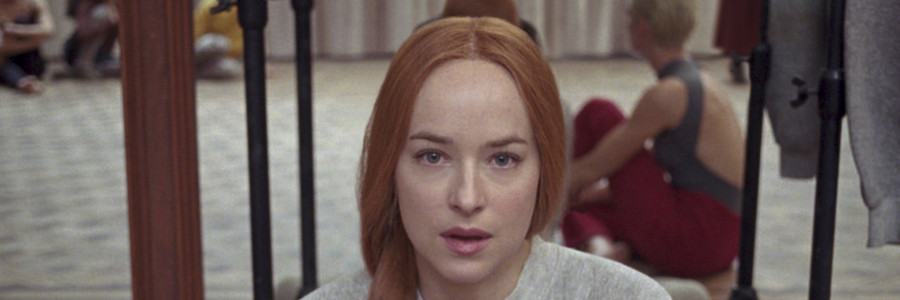Berlin, 1977. Post-war Germany remains ravaged and divided amidst the darkest days of the Cold War. Bombings ring out on the streets, while updates on the hijacking of Lufthansa Flight 181 flood the news. The city is tense and desperate…but it is not without a little magic. By the wall separating West and East Germany stands the Markos Dance Academy. Completely run by women, the self-sufficient school is a bastion of greatness in a hollow city.
Susie Bannion (Dakota Johnson), a Mennonite from Ohio, is fortunate enough to set up a meeting with the school’s head of admissions. Despite having no formal training, her powerful performance draws the attention of artistic director Madame Blanc (Tilda Swinton), and guarantees her a position.
The academy is not all that it seems, however. For all the danger that lies outside its walls, an opening sequence featuring an old psychotherapist, Klemperer (also Swinton, though credited as Lutz Ebersdorf) and a seemingly delusional student, Patricia (Chloë Grace Moretz) suggests the real threat can be found within.
Suspiria reveals this threat surprisingly early, considering its runtime of 152 minutes, in the film’s best scene. Yet as the film goes on, it’s the audience, not Susie, who become increasingly confused by the happenings at the academy. The film revolves around the idea of the women of Markos as a family, but Susie reacts to her strange experiences like a visitor at a zoo. When, on her first day, Patricia goes missing and fellow dancer Olga (Elena Fokina) accuses the matrons of complicity, Susie doesn’t blink. When she sees two of the matrons assaulting a pair of police officers investigating Patricia’s disappearance, she smiles slightly and walks away as if it were completely normal.
It’s a strange choice by Academy Award-winning director Luca Guadagnino, who halfway through Suspiria turns attention onto Klemperer and Sara (Mia Goth), a dancer who joins him to uncover Patricia’s fate. The audience already knows as much as it needs to about what’s happened to Patricia, so why spend so much time on it, especially considering the movie’s length?
What some viewers will be disappointed to find Suspiria lacking is horror. The original film by Dario Argento was primarily a horror film, and though the two versions differ greatly, it’s sure to surprise many that Guadagnino emphasises tone more than fear. The deviation from traditional horror tropes is appreciated, and the majority of the horror scenes are impactful, and feature stomach-churning practical effects, but combine this with the focus on Sara and Klemperer and you have a second act that will leave many viewers glancing at their watches.
That’s not to say Suspiria doesn’t have its appeal. Johnson delivers a strong performance, and her dancing is charged with an astonishingly feminine energy. It might feel like Susie changes as a character far too rapidly and without reason, but Johnson keeps the audience on her side.
Swinton too does a wonderful job as Blanc, Kemperer and, briefly, as the school’s head, Mother Markos. As Blanc, she is intense and maternal, embodying the theme of the film better than anything else. As Kemperer, she highlights her incredible capability, as an actress, to transform, even if the prosthetics aren’t entirely convincing in every scene. As Markos, she is simply disturbing.
The highlight of the film, however, is the cinematography from Sayombhu Mukdeeprom. With its stark, wintry palette and classic camera movements – from sweeping pans to manual zooms – Suspiria captures not just the feel of the time but the feel of a movie of the time. At times the cuts can feel erratic, but when it works, the film is a visual treat. No film has quite felt like this for a long time, and even if for that reason alone, cinemaphiles will want to check it out.
The potent dancing, choreographed by Damien Jalet, must be recognised too, along with the spellbinding soundtrack from Radiohead‘s Thom Yorke.
Suspiria ends with a sequence that – provided the rest of the film hasn’t done so – is likely to leave audiences polarised. It feels very sudden, as characters undergo changes that seem to serve a twist instead of their respective arcs. Some are likely to find a moment or two feeling silly; a problem several recent films have faced when attempting to straddle the line between horror and drama.
Whether Suspiria is a film for you is a question you alone can answer. One thing’s for sure though: for better or worse, if you see it, you won’t forget it in a hurry.
—
Suspiria opens in Australian cinemas on November 8th.

